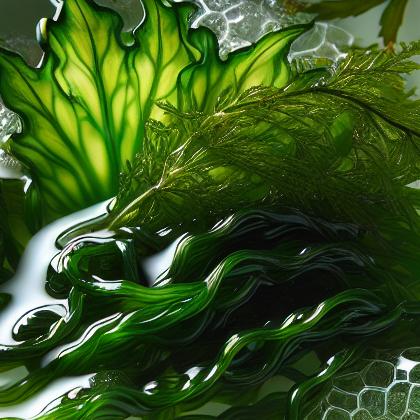Seaweed Water

Algae (/ˈældʒiː/ or /ˈælɡiː/; singular alga /ˈælɡə/, Latin for "seaweed") are a very large and diverse group of eukaryotic organisms, ranging from unicellular genera such as Chlorella and the diatoms to multicellular forms such as the giant kelp, a large brown alga that may grow up to 50 meters in length. Most are autotrophic and lack many of the distinct cell and tissue types found in land plants such as stomata, xylem and phloem. The largest and most complex marine algae are called seaweeds, while the most complex freshwater forms are the Charophyta, a division of algae that includes Spirogyra and the stoneworts.There is no generally accepted definition of algae. One definition is that algae "have chlorophyll as their primary photosynthetic pigment and lack a sterile covering of cells around their reproductive cells". Other authors exclude all prokaryotes and thus do not consider cyanobacteria (blue-green algae) as algae.Algae constitute a polyphyletic group since they do not include a common ancestor, and although their plastids seem to have a single origin, from cyanobacteria, they were acquired in different ways. Green algae are examples of algae that have primary chloroplasts derived from endosymbiotic cyanobacteria. Diatoms are examples of algae with secondary chloroplasts derived from an endosymbiotic red alga.Algae exhibit a wide range of reproductive strategies, from simple asexual cell division to complex forms of sexual reproduction.Algae lack the various structures that characterize land plants, such as the phyllids (leaf-like structures) of bryophytes, rhizoids in nonvascular plants, and the roots, leaves, and other organs that are found in tracheophytes (vascular plants). Most are phototrophic, although some groups contain members that are mixotrophic, deriving energy both from photosynthesis and uptake of organic carbon either by osmotrophy, myzotrophy, or phagotrophy. Some unicellular species such as the green algae Prototheca and Helicosporidium, and many euglenids and dinoflagellates, have become heterotrophs, sometimes parasitic, relying entirely on external energy sources and have limited or no photosynthetic apparatus. Some other heterotrophic organisms, like the apicomplexans, are also derived from cells whose ancestors possessed plastids, but are not traditionally considered as algae. Algae have photosynthetic machinery ultimately derived from cyanobacteria that produce oxygen as a by-product of photosynthesis, unlike other photosynthetic bacteria such as purple and green sulfur bacteria. Fossilized filamentous algae from the Vindhya basin have been dated back to 1.6 to 1.7 billion years ago.
Seaweed water Pairs With:
Seaweed water Properties:
| Food Property | Type | Description |
|---|---|---|
| Flavor Profile | Salty | Seaweed water has a salty flavor profile due to the natural salts present in seaweed. |
| Nutritional Value | Micronutrients | Seaweed water is rich in various micronutrients such as iodine, iron, and vitamins. |
| Texture | Moisture | Seaweed water has a high moisture content, making it hydrating and quenching. |
| Color | Natural Pigments | Seaweed water may have a greenish hue due to the natural pigments present in seaweed. |
| Aroma | Volatile Compounds | Seaweed water may have a mild oceanic aroma due to the volatile compounds released from the seaweed. |
| Chemical Composition | Water Activity (aw) | Seaweed water has a high water activity level, making it prone to microbial growth if not properly stored. |
| Cooking Behavior | Heat Conductivity | Seaweed water has low heat conductivity, meaning it may take longer to heat up compared to other liquids. |
Food Pairing App - Version 1.2.0
